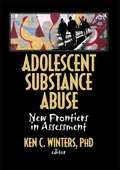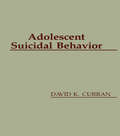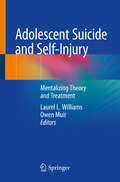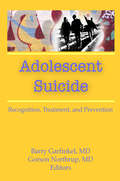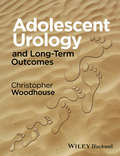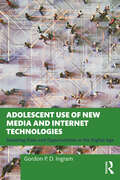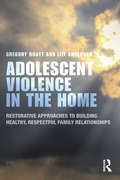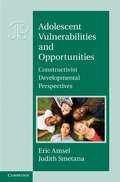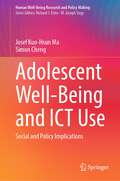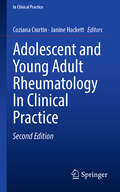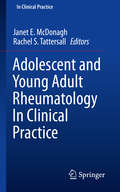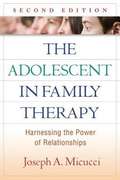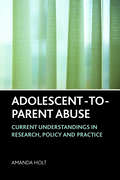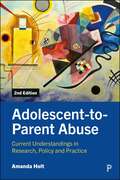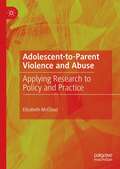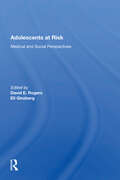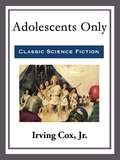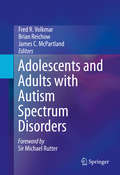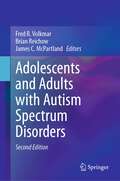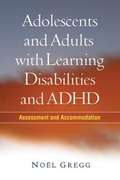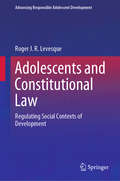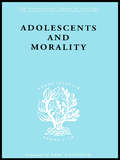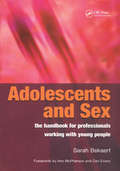- Table View
- List View
Adolescent Substance Abuse: New Frontiers in Assessment
by Ken Winters CStay up-to-date in the continuing fight to assess and treat adolescent drug and alcohol abuse Adolescent Substance Abuse: New Frontiers in Assessment presents up-to-date research on the assessment, intervention, and treatment of alcohol and drug use behaviors in adolescents, using screening tools developed to accurately measure the extent and nature of the problem. This unique book provides evidence of how the field has matured over the past 20 years, highlighting the rapid growth in research with a focus on topics deserving of more study. Leading experts working in adolescent health and assessment examine treatment-oriented typologies, treatment matching, problem identification and referral, parent-report, self-report, and the compatibility of anonymous and confidential surveys. Recent advancements in the development and evaluation of research materials have led to vast improvements in the study of adolescent drug abuse. Counselors can now depend on user-friendly features and rigorous psychometric evidence in determining the important differences between adolescent and adult drug use; distinguishing between normative and severe-end drug use behaviors; detecting "faking bad," "faking good," and other sources of compromised self-reports; and developing a greater understanding of substance abuse disorders. Still, challenges remain-the validity of adolescent self-report tools is vital; there is a need for more precise identification of related psychosocial problems, and there is a lack of data of whether current assessment tools can identify distinct levels of a problem&’s severity. Adolescent Substance Abuse works to meet those challenges. Adolescent Substance Abuse examines: how assessment can be used to identify treatment-oriented typologies to improve treatment matching how to use community readiness for drug abuse prevention how to use the psychometric data of a screening tool for problem identification urinalysis, parent report and self-report in working with American Indian youth parent-child concordance in assessment of substance use anonymous versus confidential survey formats in Mexico, Puerto Rico, and the United States gender differences in measuring substance abuse and much more Adolescent Substance Abuse is an essential professional resource for counselors and researchers working in the field of adolescent health, particularly drug abuse.
Adolescent Substance Abuse: Psychiatric Comorbidity and High Risk Behaviors
by Yifrah KaminerLearn more effective treatments for adolescents with abuse substance disorder Dual diagnosis of adolescent substance use disorders and comorbid psychiatric disorders must be treated simultaneously to be effective. Adolescent Substance Abuse: Psychiatric Comorbidity and High Risk Behaviors presents leading experts offering insightful viewpoints and dynamic suggestions on how to best provide simultaneous treatment and integrated services to these youths. The book covers the state of the art in the field of substance use disorders, and reviews different psychiatric disorders and high risk behaviors, and then addresses the issue of integrated services and ethical, legal, and policy issues pertaining to this population. In the field of adolescent substance abuse treatment, dual diagnosis is the rule rather than the exception, making assessment and treatment complicated. Adolescent Substance Abuse: Psychiatric Comorbidity and High Risk Behaviors comprehensively discusses the magnitude, etiology, and characteristics of problems and substance abuse disorders (SUD), and extensively explains ways to assess, treat, and develop services for adolescents. This unique text closely examines the assessment and treatment of psychiatric comorbid disorders among adolescents such as depression, anxiety disorders, ADHD, and high risk behaviors including suicidal behavior, self-harm behavior, and gambling behavior. The text is extensively referenced and several chapters include helpful tables and figures to clearly display the data. Topics examined in Adolescent Substance Abuse: Psychiatric Comorbidity and High Risk Behaviors include: etiology of adolescent substance abuse assessment treatment planning psychosocial interventions pharmacological interventions disruptive behavior disorders attention deficit hyperactivity disorder depression bi-polar mood disorder anxiety disorders trauma and post traumatic stress disorder (PTSD) suicidal and self-harm behaviors schizophrenia eating disorder gambling behavior Adolescent Substance Abuse: Psychiatric Comorbidity and High Risk Behaviors is an invaluable resource for mental health professionals, pediatricians, family physicians, nurses, addictions specialists, counselors, educators, students, and drug court professionals who provide assessment and treatment for youths with substance use disorders.
Adolescent Suicidal Behavior (Series in Death, Dying, and Bereavement)
by David K. CurranFirst published in 1987. Routledge is an imprint of Taylor & Francis, an informa company.
Adolescent Suicide and Self-Injury: Mentalizing Theory and Treatment
by Laurel L. Williams Owen MuirThis volume presents a comprehensive and practical approach to the treatment of suicide and NSSI for adolescents utilizing a mentalizing framework. The beginning of the text provides up-to-date information on the theory of a mentalizing therapy in order to ground the readers in the neuroscientific underpinnings of a mentalizing approach. Next chapters provide information on the fundamental building blocks of a mentalizing therapy at the individual and family level. These chapters provide step-by-step approaches in order to provide examples of the techniques involved in mentalizing treatment that can be employed to address suicidality and NSSI. The next chapter builds on these concepts as the reader learns about mentalizing failures involved in common co-morbidities in adolescents who are experiencing suicidality and/or employing NSSI. The next several chapters cover practical issues related to working within this patient population including the key concept of social systems and connections for both providers and adolescents, the ability of mentalizing theory and therapy to integrate with other effective therapies, how to approach sessions after a suicide attempt, resiliency for patient, family and the provider, along with important self-care for a therapist if a patient commits suicide. The final chapter brings all of the aforementioned elements together in order for the reader to conceptualize employing a mentalizing approach to adolescents and their families when suicide and NSSI concerns are a predominate focus of care. Illustrations of specific therapeutic approaches and a list of resources and guidelines where available are also included.Adolescent Suicide and Self-Injury is an excellent resource for all clinicians working with youths at risk for suicide and/or self-injury, including psychiatrists, psychologists, pediatricians, family medicine physicians, emergency medicine specialists, social workers, and all others.
Adolescent Suicide: Recognition, Treatment, and Prevention
by Barry GarfinkelInform yourself with thorough and accurate knowledge about the incidence of adolescent suicide. Adolescent Suicide serves to correct erroneous conceptions--held by the public and professionals--about the nature of suicidal behavior among the young, thereby promoting the opportunity for more prompt and effective evaluation and management of potentially fatal incidents. In this landmark volume, authorities address the problem of suicide among adolescents, which has emerged in recent years as a significant public health problem. In-depth discussions of the epidemiology and behavioral characteristics of youth who attempt and complete suicide, risk factors, methods of death, circumstances of the suicidal act, and reasons for the dramatic increase in the phenomenon provide social workers, educators, psychologists, and psychiatrists with systematic information that can be used in both prevention and intervention efforts. There is also a wealth of valuable material here on school-based suicide prevention programs, strategies for managing and counseling the relatives, peers, and classmates of individuals who have committed suicide, and coping with suicide in residential treatment centers.
Adolescent Therapy that Really Works: Helping Kids Who Never Asked for Help in the First Place
by Janet Sasson EdgetteEdgette proposes a unique approach to relating to adolescents in therapy. Focusing on establishing genuine and unaffected relationships between therapists and teens, this book offers techniques for clinicians who want to engage and connect with their adolescent clients. The goal is to bring about conversations that are candid and therapeutically effective so that teens and their families can find dignified and durable solutions to their problems. Case examples and stories from Edgette’s own practice illustrate how therapists can successfully navigate difficult encounters, avert power struggles, and avoid dead-end dialogues that bore teenage clients and stall treatment. Thorough and lucidly written, Adolescent Therapy That Really Works shows therapist how to become partners with their clients, maintain their authority while also drawing teens into comfortable conversation, and read body language and facial expressions to better convey understanding and respect. Every therapist who works with adolescents and their families will benefit from the wisdom, skill, and honesty exhibited in Edgette’s therapeutic approach.
Adolescent Urology and Long-Term Outcomes
by Christopher R. WoodhouseAdolescent Urology and Long-Term Outcomes provides urologists and pediatric urologists with a comprehensive and expert clinical guide to the main urologic problems that can occur during adolescence. Fully covering disorders related to sex and genital development, the kidney, bladder, ureta and urethra, Professor Woodhouse, a world-leading expert and global pioneer in this field systematically outlines the best clinical practice in the surgical and medical management of these complex and extremely challenging conditions, as well covering the long-term outcome for the patient. Given the sensitive nature of these problems and their effect on adolescent patients, attention is paid to the psychological aspect of such disorders: especially how best to manage patients struggling to come to terms with what are very personal and complex issues at what is often a difficult and turbulent period of their life. Well-illustrated with over 120 figures including step-by-step surgical diagrams throughout, chapters will also include a unique "voice of the experts" feature - a running dialogue between leading experts and Prof Woodhouse on the topic in question. This modern, expert guide to adolescent urologic problems from one of the leading names in the field will be an essential tool for modern-day urologists and urologic surgeons, especially those specialising in pediatric patients, as well as pediatricians and endocrinologists.
Adolescent Use of New Media and Internet Technologies: Debating Risks and Opportunities in the Digital Age
by Gordon P. IngramThis book engages with contemporary, and often polarizing, debates surrounding the risks of adolescent use of digital media and internet technologies. By drawing on multiple research studies, the text synthesizes current understandings of the impacts of social network use, online gaming, pornography, and phenomena, including cyberbullying, cyberstalking, and internet addiction, to develop recommendations for the effective identification of at-risk youth, as well as strategies for informed communication about online risks and opportunities. It shows how media discussion of risks to children and teenagers from new technology is highly emotive and often exaggerated, rooted in the “moral panic” surrounding new cultural practices that young people engage in, but which adults do not understand. Online risks are thus conceptualized as centering on three areas, specific to adolescence, which have undergone radical changes due to new internet technology. These include young people’s identity, the types of content that are accessed, and social relationships. The author shows how these matters stem from the potential of new technology to establish new interpersonal connections, emphasizing how it brings opportunities, as much as risks. As such, he provides a uniquely balanced discussion of potential dangers, while also emphasizing the opportunities for social, academic, and personal growth which new technologies afford young people. It will be indispensable for researchers and clinicians interested in assessing levels of online risk, as well as scholars and educators with interests in cyberpsychology, social psychology, cyber culture, social aspects of computing and media, and adolescent development.
Adolescent Violence in the Home: Restorative Approaches to Building Healthy, Respectful Family Relationships
by Lily Anderson Gregory RouttAdolescent Violence in the Home examines a form of violence that has a profound impact on families but is often overlooked and frequently misunderstood: teen aggression and violence toward members of their family—especially parents. Violence in adolescents is often seen as the result of a mental-health diagnosis, delinquency, or as a response to dysfunctional parenting, and though understanding a youth’s mental-health status or a parenting style can be helpful, complete focus on either is misplaced. Adolescent Violence in the Home uses a restorative framework, developed by the authors and in use in court systems and organizations around the world, to situate violent behaviors in the context of power and the intergenerational cycle of violence. Readers will come away from this book with a profound understanding of the social and individual factors that lead youth to use violence and how adolescent violence affects parents, and they’ll also learn about a variety of interventions that specifically address teen violence against parents.
Adolescent Vulnerabilities and Opportunities
by Judith Smetana Eric AmselThis book explores the central importance of adolescents' own activities in their development. This focus harkens back to Jean Piaget's genetic epistemology and provides a theoretically coherent vision of what makes adolescence a distinctive period of development, with unique opportunities and vulnerabilities. An interdisciplinary and international group of contributors explore how adolescents integrate neurological, cognitive, personal, interpersonal and social systems aspects of development into more organized systems.
Adolescent Well-Being and ICT Use: Social and Policy Implications (Human Well-Being Research and Policy Making)
by Simon Cheng Josef Kuo-Hsun MaIn this book, the authors expertly examine the issue of adolescent well-being in the light of their exposure to and use of information and communication technologies (ICTs) at school and home. The authors discuss a new form of inequality especially noticeable among youth, which is, digital inequality/divide, created through rapid developments in ICT. They analyze the relation between digital divide and educational inequality among youth, describe patterns of social exclusion from technology and education, and discuss related policies in industrialized nations to see how well-being issues can be addressed in this context. Comparing results based on nationally representative and internationally comparative datasets across 28 countries, the authors ask how and why the benefits accruing from ICT are substantially greater for some adolescents, but apparently smaller for others and how such differences may be reduced. They provide policy suggestions that are broadly based in the fields of well-being, secondary education, and technology use. This book is of interest to researchers and students of quality of life and well-being studies and a wide range of social science and education disciplines, including the sociology of education, media sociology, sociology of childhood and adolescence, communication studies, and science and technology education.
Adolescent and Young Adult Rheumatology In Clinical Practice (In Clinical Practice)
by Coziana Ciurtin Janine HackettThis concise guide takes a practical approach to adolescent and young adult (AYA) rheumatology, encompassing the needs of any healthcare professional working with young people aged 10-24 years. Each chapter contains key management points for readers to readily access disease-specific management, as well as highlighting specific AYA issues and approaches which differ from paediatric and adult practice. Adolescent and Young Adult Rheumatology In Clinical Practice, 2nd Edition has been fully revised with the latest research and clinical findings in the field. The coverage in the book is comprehensive but concise and devised to act as a primary reference tool for AYA practice across the field of rheumatology. The book is designed for paediatric/adult rheumatologists, primary care physicians, nurses and allied health professionals to increase understanding of AYA related topics and enhance the delivery of developmentally appropriate rheumatology health care.
Adolescent and Young Adult Rheumatology In Clinical Practice (In Clinical Practice)
by Janet E. McDonagh Rachel S. TattersallThis concise guide takes a practical approach to adolescent and young adult (AYA) rheumatology, aiming to cover the needs of any healthcare professional dealing with young people aged 10-24 years. Each chapter contains key management points for readers to readily access disease-specific management as well as highlighting specific AYA issues which differ from pediatric and adult practice. The coverage is comprehensive but concise and designed to act as a primary reference tool for subjects across the field of rheumatology. The book is designed for pediatric/adult rheumatologists, primary care physicians, nurses, allied health professionals and other professionals to understand each topic covered and to take a practical approach to delivering developmentally appropriate rheumatology health care.
Adolescent in Family Therapy, Second Edition
by Joseph Micucci Celia FalicovRich with clinical wisdom, this successful text and practitioner guide offers a comprehensive framework for treating adolescent problems in the family context. Even as teenagers become increasingly independent, Joseph Micucci shows, they still need parental guidance and nurturance. By strengthening family relationships, clinicians can alleviate symptoms and promote behavioral change. Vivid examples and session transcripts illustrate specific strategies for treating eating disorders, depression, anxiety, defiance, underachievement, and other frequently encountered challenges. Weaving together family therapy techniques with ideas from psychodynamic and cognitive-behavioral approaches, the book has a pragmatic focus on effective interventions for getting adolescent development back on track. New to This Edition Thoroughly updated to reflect current research and reader feedback. Chapter on adolescent anxiety disorders. Expanded coverage of attachment issues; lesbian, gay, and bisexual youth; and racial and ethnic identity. New case material, one of the book's most popular features.
Adolescent-to-Parent Abuse: Current Understandings in Research, Policy and Practice
by Amanda HoltWhile much has been written about the problematic behaviour of young people and their families, there has been silence on the problem of young people behaving abusively towards their parents, which may take the form of physical, economic and/or emotional abuse. This is the first academic book to focus on adolescent-to-parent abuse and brings together international research and practice literature and combines it with original research to identify and critique current understandings in research, policy and practice. It discusses what we know about parents' experiences of adolescent-to-parent abuse and critically examines how it has been explained from psychological, sociological and sociocultural perspectives. It also outlines how policymakers and practitioners can usefully respond to the problem. This unique book adopts a range of theoretical and practice perspectives. Written in an accessible style, it is an essential tool for academics, policymakers and professionals with an interest in domestic violence, child protection and youth offending.
Adolescent-to-Parent Abuse: Current Understandings in Research, Policy and Practice
by Amanda HoltSince publication of the first edition, awareness of, and interest in, adolescent-to-parent abuse has risen considerably. Thoroughly revised and updated to incorporate the latest research and developments in policy and practice, this second edition provides a comprehensive overview of the key issues and current responses to the challenges in dealing with this unique form of family abuse. Exploring the experiences and impact of adolescent-to-parent abuse on individuals, families and communities, this book extends the field to include issues relating to neurodiversity, kinship care, trauma, adult-aged perpetration and fatal violence. Throughout the book, leading expert Amanda Holt challenges existing policy frameworks while offering practical insights for work with families, parents/carers and young people who are experiencing this problem. A key text for academics, researchers, students and practitioners in psychology, sociology, criminology, social work and social policy, this book provides essential guidance for understanding and addressing this complex and pressing issue.
Adolescent-to-Parent Violence and Abuse: Applying Research to Policy and Practice
by Elizabeth McCloudThis book seeks to break new ground in the way in which adolescent-to-parent violence and abuse is understood. Incorporating knowledge from an original research project undertaken in the UK and international literature, this book provides insight into the prevalence of this form of domestic violence which can include psychological, physical, and economic abuse. Young person and family characteristics are explored, and links are made between sibling aggression and school bullying behaviours. A key theme is how the data can be used to develop statistical models which can screen for young people behaving abusively towards their parents. It discusses how the research can be applied to inform theoretical frameworks, policy development, and professional practice, with a focus on prevention and early intervention that uses positive youth justice and restorative approaches.
Adolescents At Risk: Medical and Social Perspectives
by David E. RogersThis text seeks to examine the factors that cause teenage violence, risky sexual behaviour (including risk of AIDS), and alcohol and drug abuse. It also addresses the guidelines that should be followed by those who seek to reduce societal costs resulting from the disfunctional behaviour of young people unable to make the transition from adolescence to young adulthood without special assistance and support.
Adolescents Only
by Irving Cox Jr.Elvin wasn't sure how it had started--maybe it was the Schermerhorn twins--or the mysterious "meteorite"--or else the world had gone crazy . . . .
Adolescents and Adults with Autism Spectrum Disorders
by Fred R. Volkmar Brian Reichow James C. McpartlandThe research on children with autism spectrum disorders (ASD) is extensive and growing. Although these conditions are recognized as affecting the entire lifespan, the literature on ASD after childhood is limited and has not been brought together in a single volume in over a decade. Adolescents and Adults with Autism Spectrum Disorders fills this knowledge gap by focusing on needs and difficulties unique to these stages of development. Expert contributors offer cogent reviews of complex issues, from education to employment, leisure activities to illegal behaviors, mental health issues to medical health concerns. The latest findings in key areas, such as psychosocial and residential treatments, social skills programs, epidemiology, the impact of ASD on families, are examined in detail. Throughout the volume, coverage focuses on areas requiring improved models of assessment, updated data, new interventions and increased support services. Featured topics include: Transition from high school to adulthood for adolescents and young adults with ASD. Innovative programming to support college students with ASD. Romantic relationships, sexuality and ASD. Treatment of mental health comorbidities. Assessment and treatment planning in adults with ASD. The range of outcomes and challenges in middle and later life. Adolescents and Adults with Autism Spectrum Disorders is a must-have reference for a wide range of clinicians and practitioners - as well as researchers and graduate students - in clinical child, school and developmental psychology; child and adolescent psychiatry; social work; rehabilitation medicine/therapy; education and general practice/family medicine. It will also serve as an important resource for parents and caregivers with its focus on translating the current state of knowledge relevant to understanding adolescents and adults with ASD into practical and relevant recommendations on how best to support them.
Adolescents and Adults with Autism Spectrum Disorders
by Fred R. Volkmar Brian Reichow James C. McPartlandThe second edition of this book examines the numerous research and practice advances with regard to adolescents and adults with autism spectrum disorders (ASD). Expert contributors offer cogent reviews of complex issues, from education to employment, leisure activities to illegal behaviors, mental health issues to medical health concerns. The volume explores the latest findings in key areas, such as psychosocial and residential treatments, social skills programs, epidemiology, the impact of ASD on families. The book focuses on areas of research and practice that require improved models of assessment, current data, new interventions, and increased support services. Key areas of coverage include: Transition from high school to adulthood for adolescents and young adults with ASD. Innovative programming to support college students with ASD. Romantic relationships, sexuality and ASD. Treatment of mental health comorbidities. Assessment and treatment planning in adults with ASD. The range of outcomes and challenges in middle and later life for individuals with autism. The second edition of Adolescents and Adults with Autism Spectrum Disorders is a must-have reference for researchers, professors, and graduate students as well as clinicians, therapists, and other practitioners in clinical child, school, and developmental psychology, psychiatry, social work, rehabilitation medicine/therapy, special education, and general practice/family medicine.
Adolescents and Adults with Learning Disabilities and ADHD
by Noël GreggMost of the literature on learning disabilities and attention-deficit/hyperactivity disorder (ADHD) focuses on the needs of elementary school-age children, but older students with these conditions also require significant support. Comprehensive and authoritative, this book helps educators and clinicians navigate the maze of laws, policies, and scientific research relating to diagnostic and intervention decision making for adolescents and adults. Leading expert No\u00ebl Gregg provides clear guidance on how to conduct and document evidence-based assessments and select appropriate instructional and testing accommodations. Featuring helpful case vignettes, decision-making flowcharts, and coverage of the latest assistive technologies, the book gives special attention to supporting students during the crucial transition from high school to higher education or vocational settings.
Adolescents and Constitutional Law: Regulating Social Contexts of Development (Advancing Responsible Adolescent Development)
by Roger J. LevesqueThis textbook offers a foundation for understanding adolescents’ rights by articulating the complexity, breadth, and challenging nature of laws regulating adolescents. It showcases the Supreme Court’s key interpretations of the Constitution as it relates to adolescents’ rights. Chapters examine relevant legal systems and the social contexts that legal systems control. In addition, chapters discuss constitutional issues and their nuances through actual cases that often offer alternative interpretations of constitutional rules. The textbook guides readers through both well accepted and often ignored conceptions of adolescents’ rights. It offers readers unfamiliar with the law the tools they need to understand the importance of adolescents’ constitutional rights and how they can contribute to developing them. Topics featured in this text include: The role of parents and family systems in conceptualizing adolescents’ rights.The complexities of providing health care to adolescents.Religious freedom and adolescents’ rights relating to religion.The flaws of child welfare systems.The challenge of developing rights specifically for juveniles and delinquent youth.Juvenile court systems and the differential treatment of adolescents.The difference between the juvenile court system and the criminal court system.Adolescents’ media rights. Adolescents and Constitutional Law is an essential textbook for graduate students as well as a must-have reference for researchers/professors and related professionals in developmental psychology, juvenile justice/youth offending, social work, psychology and law, family studies, constitutional law, and other interrelated disciplines.
Adolescents and Morality: A Study Of Some Moral Values And Dilemmas Of Working Adolescents In The Context Of A Changing Climate Of Opinion (International Library of Sociology)
by E.M EppelThe groundbreaking works in The Sociology of Youth and Adolescence set of the International Library of Sociology led the way to an authoritative understanding of how social interaction moulded young people. Careful observation of vulnerable and troubled children helped the leading sociologists, whose works are included in this set, to investigate how aggression, discipline, the struggle for recognition and the need to rebel shaped the personalities of the young. These are important texts for practitioners, students and teachers in health and social welfare.
Adolescents and Sex: The Handbook for Professionals Working With Young People
by Sarah BekaertWorking with young people can present many challenges. Sexual health and contraceptive issues with teenagers often raise legal, ethical and sometimes child protection concerns. This comprehensive and practical guide is packed with useful advice on contraceptive methods, sexually transmitted infections, adolescent, legal and ethical issues. It is presented in an easy to read format that can be dipped into when required and highlights how a young persons' clinic can be set up and how existing services can be made more approachable. This book will serve as a useful, quick reference and all those working with young people will find it valuable reading.
